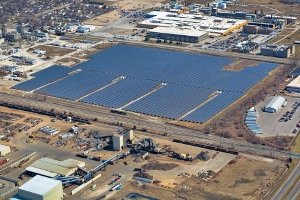Apr 11 2014
Hanwha Q CELLS, an international solar developer, manufacturer and solutions provider, commemorated the historic completion of the first utility scale solar project constructed on an active EPA Superfund site.
Hanwha Q CELLS was joined by project partners including the US EPA, Vertellus Specialties Inc., Indiana Department of Environmental Management, Indiana Power & Light (NYSE: AES), PNC Bank, August Mack Environmental Consulting, URS Corporation, US Utilities and Solar FlexRack.
 Hanwha Q CELLS, an international solar developer, manufacturer and solutions provider, today commemorated the completion of the first utility scale solar project constructed on an active EPA Superfund site. As part of the commissioning of the 10.86MWdc Maywood Solar Farm, company officials were joined by the EPA Regional Administrator and other key project partners for a ribbon-cutting ceremony at the former Reilly Tar & Chemical Superfund site in Indianapolis, IN. (Photo: Business Wire)
Hanwha Q CELLS, an international solar developer, manufacturer and solutions provider, today commemorated the completion of the first utility scale solar project constructed on an active EPA Superfund site. As part of the commissioning of the 10.86MWdc Maywood Solar Farm, company officials were joined by the EPA Regional Administrator and other key project partners for a ribbon-cutting ceremony at the former Reilly Tar & Chemical Superfund site in Indianapolis, IN. (Photo: Business Wire)
The 10.86MWdc Maywood Solar Farm, located on 43 acres of the Reilly Tar & Chemical Superfund site in Indianapolis, was completed under the 2012 Indianapolis Power & Light (IPL) Rate-REP program. Of critical significance, the Maywood Solar Farm was fully realized without additional federal, state, local or corporate incentives and used conventional solar project financing. Construction commenced in July 2013 and was completed in March 2014, using high efficiency Q CELLS Q.PRO L polycrystalline modules, engineered by Hanwha Q CELLS in Germany. The Maywood Solar Farm will operate for up to 30 years and reduce CO2 emissions by more than 13,000 metric tons per year – equal to the annual carbon emissions of more than 2,700 passenger cars or 1,800 Indiana residential homes.
Hanwha Q CELLS’ CEO Charles Kim remarked: “The completion of the Maywood Superfund project is a significant milestone for Hanwha Q CELLS, but also for the solar industry as a whole in overcoming the legal, financial, regulatory and construction hurdles to create a virtuous cycle, and develop a higher use for brownfield, idle land. In completing a non-subsidized Superfund project, Hanwha Q CELLS has broken a barrier that has frustrated solar project developers for more than 20 years. We are looking forward to future, similar projects.”
Safeguarding project economics, Hanwha Q CELLS completed project construction at, or below, market costs – while managing additional site and environmental requirements. Hanwha Q CELLS employed an internally-developed and adaptive construction methodology in concert with US EPA to meet existing site environmental covenants. The proprietary Hanwha Q CELLS Soil Disturbance Minimization Plan resulted in a volume reduction of site soil movement of more than 93% over conventional construction approaches, while also minimizing the potential for exposing known underground hazards, impairing the existing site environmental remedy, or creating human exposure to site hazards.
“This innovative solar project demonstrates that Superfund sites can be redeveloped – to generate economic benefits for the local community and clean renewable energy for homes and businesses," said US EPA Regional Administrator Susan Hedman. "US EPA is proud to have played a role in the Maywood Solar Farm project, which has transformed a site with a long history of contamination into a source of renewable energy for the future."